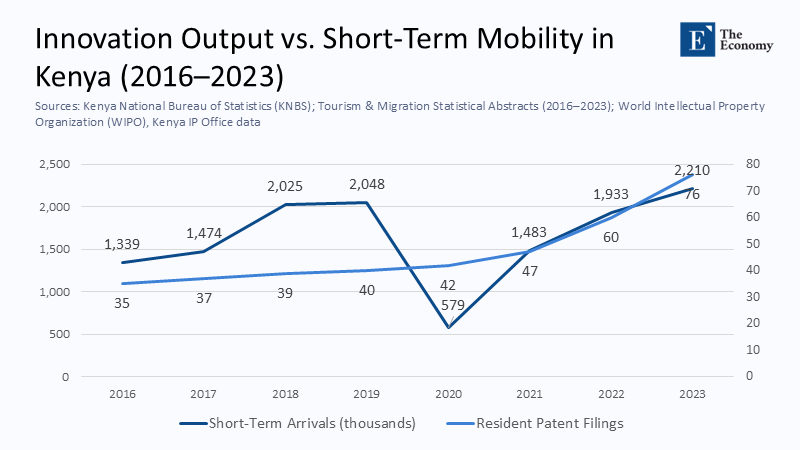Input
Changed
This article is based on ideas originally published by VoxEU – Centre for Economic Policy Research (CEPR) and has been independently rewritten and extended by The Economy editorial team. While inspired by the original analysis, the content presented here reflects a broader interpretation and additional commentary. The views expressed do not necessarily represent those of VoxEU or CEPR.

The Causal Mirage
There is a seductive neatness in the claim that the bustle of short‑term travellers landing in African capitals unfailingly triggers fresh bursts of invention. Many readers of the recent VoxEU study have walked away convinced that the arrow of causality runs cleanly from footfall to patent filing. Yet causality in the real world is seldom so well‑behaved. An entrepreneur who unveils a breakthrough fintech platform in Nairobi does not merely wait for foreign specialists to arrive; the very press release about the launch is an invitation that fills inbound flights. If we do not stop to ask which event sets the other in motion, we risk designing policy on the strength of a statistical mirage.
The Lure of Velocity
The post‑pandemic rebound in cross‑border movement has been dramatic. The World Bank estimates that, by December 2023, the globe had logged roughly 1.286 billion international trips, a year‑on‑year leap of 34 percent that restored travel flows to eighty‑eight percent of their 2019 level. Sub‑Saharan hubs such as Addis Ababa, Nairobi, and Kigali punched well above their historic weight in this recovery because they combined two attractions: vaccines and visas. Ethiopian Airlines, for example, flew the flag not only for rapid PCR testing but also for an e‑visa system that, after June 2018, allowed applicants from anywhere in the world to obtain a 30‑day entry document online. Industry analysts credit the measure with a 29 percent surge in foreign arrivals within the first full calendar year of adoption.
The same months that brought those travellers also produced remarkable spikes in research activity. According to the World Intellectual Property Organization’s 2024 indicators, Africa as a whole recorded the fastest percentage growth in resident patent applications of any region, albeit from a low base. Ethiopia, specifically, filed 28 percent more resident patents in 2023 than in 2022. The temptation is strong to stitch the two facts together and proclaim a cause. But causality demands distance; when a change in one variable triggers brisk adjustment in another, econometricians need a shock that moves the first variable without simultaneously broadcasting the second.
Untangling the Feedback Knot
Economists refer to the trap of 'simultaneity bias' as a situation where a nation’s spike in innovation itself becomes a magnet that draws consulting engineers, interim CFOs, and venture capital scouts. Any regression that takes mobility as an independent variable will overstate its influence. In simpler terms, if a country's innovation attracts foreign experts, a statistical analysis that doesn't account for this attraction will mistakenly attribute mobility.
Traditional methods for correcting the problem of simultaneity bias reach for instrumental variables—shocks that move mobility but are unrelated to contemporaneous inventive energy. For instance, sudden visa‑fee waivers targeted at a narrow set of countries or new fifth‑freedom air‑service agreements that reroute transit traffic through a particular hub are examples of such instrumental variables. These methods help to isolate the effect of mobility on innovation from other factors.
Yet Africa rarely presents perfectly clean experiments. Migration policies are often bundled with investment‑promotion packages, while route negotiations are announced alongside trade fairs that showcase local ingenuity. Some of the cleanest variations have instead come from the diaspora. Alum associations of African scientists now employed at North American and European universities periodically organise research sabbaticals that send dozens of specialists home for three‑week collaborations. The timing depends more on semester breaks than a Kenyan SME’s internal product roadmap, offering a quasi‑random infusion of high‑skill labour.

Country Vignettes: Ethiopia, South Africa, Kenya
Ethiopia’s 2018 e‑visa is something of a natural experiment in real-time. Tourism analysts tracked a dramatic acceleration in short‑stay entries in 2019, when resident patent filings, admittedly small in absolute terms, barely moved. That mismatch suggests the visitor surge pre‑dated meaningful shifts in inventive output, reinforcing the study’s core thesis that mobility can precede innovation.
Contrast that with South Africa, where Parliament extended a 150‑percent R&D tax super‑deduction beyond its original sunset date in 2020. The finance ministry intended the incentive to ignite local experimentation in sectors as diverse as green hydrogen and medical diagnostics. The 2024 Science, Technology and Innovation indicators report nonetheless records a 23.3 percent drop in patent filings between 2022 and 2023, driven almost entirely by foreign applicants stepping back from the South African market. In the wake of that slump, short-term arrivals remained tepid, a pattern inverted from the Ethiopian one and suggestive that the disappearance of foreign expertise followed rather than preceded the innovation slowdown.
Kenya offers a third configuration. Nairobi’s fintech ecosystem, anchored by the success of mobile‑money pioneers a decade earlier, has become a launchpad for dozens of micro‑lending and cross‑border remittance start‑ups. Each funding round garners international headlines that attract specialist software auditors and compliance lawyers on month‑long assignments. Immigration records for Jomo Kenyatta International Airport reveal that business visa arrivals spike in the fortnight immediately following major Series B announcements. The temporal ordering—news of cash injections first, visitors second—flips the putative causal chain again.

The Role of Diaspora Currents
Where state‑to‑state or firm‑to‑firm flows complicate identification, the African scientific diaspora supplies a subtler test. Ghanaian immunologists embedded in London teaching hospitals often return each August to run abbreviated courses at the Noguchi Memorial Institute. Because these returnees’ schedules depend more on UK term breaks than Ghanaian policy announcements, the two‑week laboratories offer a unique mobility shock largely exogenous to local innovation cycles. Preliminary micro‑data from the Ghana Health Service indicate that patentable diagnostics prototypes filed by Noguchi groups rise roughly six months after the diaspora visits, hinting at a lagged causal channel that flows from visitor to invention rather than the reverse.
Data, Devices, and Natural Experiments
Convincing measurement, however, demands more than anecdotes. Airlines possess high‑frequency passenger manifest data that can be matched to corporate innovation metrics such as patent applications, open‑source code contributions, or new‑product release notes. The granular dates allow researchers to deploy difference‑in‑differences designs in which regions newly connected by non‑stop flights serve as treatment groups and unconnected regions as controls. Instrumental‑variable strategies then use exogenous determinants of flight routing—jet‑fuel price shocks, bilateral air‑service treaties, or even volcanic ash disruptions—as levers that push mobility while leaving local R&D untouched.
Another burgeoning dataset is the online professional profile. LinkedIn’s “open to work” flags make it feasible to approximate the itineraries of highly skilled contractors who treat Africa as a project base while retaining residence elsewhere. When an influx of contractors with machine‑learning expertise precedes a spike in domestic digital health patents by a quarter, the time‑stamped profiles help establish directionality.
Policy Sequencing: From Proof to Scale
Policy implications crystallise once simultaneity is acknowledged. Governments eager to turn airports into idea exchanges must start with well‑timed liberalisation rather than with ad‑hoc subsidies. A visa‑on‑arrival regime that comes into force six months before the first tech‑park ground‑breaking provides statisticians with the clean differential they need to evaluate the policy’s independent effect. If, conversely, the visa reform lands after the innovation campus ribbon‑cutting, officials will never know whether later patent growth stems from looser borders or flashy co‑working spaces.
Accommodation must also shift from counting heads to mapping complementarities. Africa hosts scarcely one per cent of global patents but seventeen per cent of humanity. The constraint is not raw numbers of visitors but the match between visiting expertise and local capability gaps. For instance, Rwanda’s ambitious plan to become a biomedical manufacturing hub does not hinge on attracting scores of generic consultants; it hinges on landing a handful of cold‑chain and regulatory affairs specialists whose knowledge bears sharply on the nation’s vaccine‑packaging ambitions.
Finally, diaspora networks should be recognised not as sentimental add‑ons but as strategic, quasi‑random channels for identifying causal links. Because alumni‑driven programmes seldom coincide with high‑profile domestic policy launches, their mobility shocks arrive cleaner than those generated by tourism carnivals or summit diplomacy. Embedding small‑grant schemes within these return visits helps researchers parse whether knowledge embedded in the diaspora can jump‑start local patenting without the fanfare that typically confounds inference.
Designing Loops, Not Lines
Mobility and innovation in Africa are entwined, but the strands wrap in both directions. The continent’s recent ascent in the Global Innovation Index—Mauritius now leads at rank fifty‑five, Morocco has climbed vigorously since 2014, and Kenya broke into the top hundred in 2024. WIPO owes something to the rush of visiting specialists who seed know‑how. Yet each act of African creativity is a beacon that summons the next wave of itinerant talent. The wise policy does not merely celebrate that dynamism; it stages it, sequencing liberalisation before infrastructure, piloting visa corridors before showering tax credits, and field‑testing identification strategies before claiming triumph. The goal is to convert the ambiguity of simultaneity from a statistical nuisance into an engine: when openness indisputably triggers discovery, and discovery demonstrably deepens openness, the feedback turns virtuous.
The continent’s innovation history need not be written as a straight line from mobility to patents. It can be authored as a carefully designed circle—tight enough for feedback to accelerate, but transparent sufficient for causality to be proven. Africa’s innovators, investors, and citizens deserve that empirical integrity, because only with it can the loop be engineered to spin faster rather than fracture.
The original article was authored by Linguère Mously Mbaye, a Manager of the Country Economics Division for Central, North, and West Africa at the African Development Bank. The English version of the article, titled "Short-term labour mobility drives innovation in Africa,” was published by CEPR on VoxEU.





















